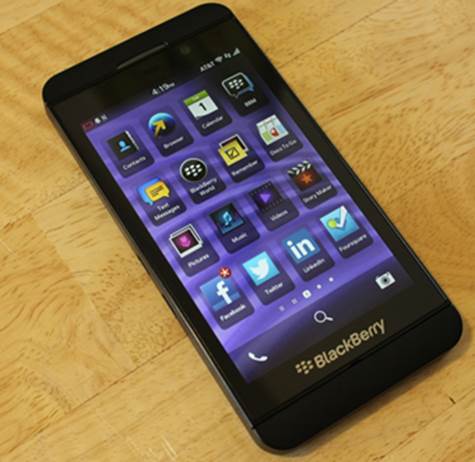BB10 has landed on the Z10. Does it
signal a renaissance for the once-great phone maker or have its efforts been
fruitless?
BlackBerry has had a turbulent time of
late, with falling profits and the departure of co-CEOs. The release of the Z10
and the new BB 10 operating system heralds a new beginning, but with Apple and
Samsung yet to release their own flagships for 2013 has the now-renamed RIM
done enough?

BlackBerry
Z10
If first impressions were all, the answer
would be no. The Z10’s design is understated and underwhelming in either
all-black or a slightly more eye-catching white on black. Its large glass front
is sandwiched by two plastic ends with a rubberized back covering the rear. It
lacks the panache of the iPhone, Galaxy S3 and Lumias, but it is business-like.
Measuring 9mm thick, it’s chunky by recent
smartphone standards, while the quality of the build leads you to use
descriptive such as “not bad” and “durable” rather than “gorgeous” or “rock
solid”.
The OS doesn’t welcome you in either. Like
the PlayBook, there’s no home button – you swipe up from the bottom to go back
to the start, and also to unlock – and swiping introduces an initially
confusing choice of open apps and home screens.
However, stick with it and it begins to
make sense. The UI flows very sweetly once you’ve mastered it, and the screen
is very good. At 4.2 inches and 1280x768, it boasts a pixel density that
exceeds Apple’s iPhone 5 and, although it copes less well in direct sunlight,
the screen’s sharpness really impresses. Its size is limited due to the thick
bezel – which is again a function of BB10, as many of the main gestures in BB’s
new OS are performed by finger-swiping off of the bezel onto the display.

At
4.2 inches and 1280x768, it boasts a pixel density that exceeds Apple’s iPhone
5 and, although it copes less well in direct sunlight, the screen’s sharpness
really impresses
Once unlocked, you’re greeted with
BlackBerry business as usual: a series of app icons split over an unlimited
number of windows. When you open an app things get more interesting. An app can
be minimized by swiping up, turning it into an “Active Frame”: essentially a tile
or widget that updates in real-time. Apps such as The Guardian show a brilliant
slideshow of breaking news images, but others are less successful – a miniature
version of an app’s screen is of no help really, with all content virtually
illegible.
Central to the BB10 operating system is the
Hub; a stream of notifications encompassing all of your accounts, from Gmail to
Twitter, via Facebook, LinkedIn and many more. It shows emails alongside
updates and birthday alerts. As a running ticker of your contacts and
commitments it’s a helpful addition for business users and heavy social
networkers alike.
BlackBerry also addresses the issue of the
work/life split, with BlackBerry Balance. This separates the Z10 into work and
play profiles, with each totally independent of the other. The Z10 also needs
to attract users with an Android- and Apple-matching range of media and apps.
The BlackBerry World store isn’t there yet, but it’s a lot better, with a wide
range of hi-def. blockbusters and the entire singles music chart.
There are more than 70,000 apps available
at launch, and while that’s far fewer than iOS or Android, they do include many
of the ones that people actually use, with big names including Skype, Angry
Birds and WhatsApp, with Instagram coming soon.

The
solid build and slightly rubberized back gives the Z10 a durable feel
Ensuring the smooth running of all this new
content is the Z10’s 1.5GHz dual-core processor and 2GB of RAM. That may not
match recent quad-core “super phones” but, as with the iPhone, the fact that
BlackBerry makes both the hardware and the software means performance is
optimized nicely.
BlackBerry cameras have not been great in
the past, but the Z10 rights that to an extent, with an eight-megapixel snapper
on the back and two-meg optics up front. One of its key features is Time Shift,
where a burst of pictures is taken, allowing you to switch individual elements
of the picture. Take a group shot and someone’s blinking? You can swap in their
face from a second before.
Despite the option to clean up your snaps,
the results are nothing special. Photos are generally clear but a little dark
and you have to drag and drop where you want to focus, making point-and-shoot a
slow process.
The full-HD video impresses more, and there
are some excellent BB video-editing apps available too.

BlackBerry
cameras have not been great in the past, but the Z10 rights that to an extent,
with an eight-megapixel snapper on the back and two-meg optics up front.
One thing that’s clearly missing from the
Z10 is a QWERTY keyboard – for those that feel they can’t live without it
there’s the Q10 which is coming “soon”. Instead the Z10 has a “learning”
touchscreen keyboard that sweeps your emails and texts, learning your common
phrases, names and expletives then using them to make predictive text a
personalized experience. It works very well, and should improve further over
time.